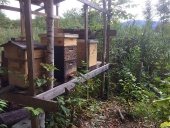Hello, I have been researching Bees for almost a year now. I have joined my local club and will be going to a beginners class next month. After agonizing over the kind of hive, I have decided the bees don't care, so why not make it easy for me. I am going with the advice I found on Bush Bees Farm site, using all medium 8 frames with a top entrance and foundation-less frames.
In Virginia right now there is a grant program through the state agriculture and consumer agency. They will reimburse the cost of a hive up to $200. The hive must have the volume of at least two deep 10 frames and must have movable frames. The hive materials must be purchased from a recognized vendor or club. Used hives and homemade hives are not eligible. For more details see link:
http://www.vdacs.virginia.gov/plant&pest/pdf/Guidelines%20for%20Beehive%20Grant%20Fund%20Program%206_2014.pdf?File=C:/TownHall/docroot/GuidanceDocs/301/GDoc_VDACS_5098_v2.pdf After speaking with the state Apiarist he told me that it can take six to twelve months to receive the funds.
My goal is to start two hives next spring. I want to use a no-chemical-treatment method. I plan to use crush and strain method of honey harvesting. I have attached a breakdown of estimated cost of the hive and the tools. I am going with the bare bones approach. For protection I will use a hat with sown on veil, and gloves. I will wear white overalls and rubber boots with ankle straps.
I need to show my wife that an investment in hives and equipment will give a greater R.O.I. than a savings account and will pay for itself in a few years.
Please take a look at the attachment and tell me where I am all wrong with my numbers and hive setup.
thanks,
Jason




























 1
1














